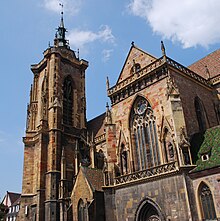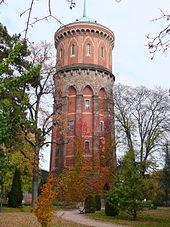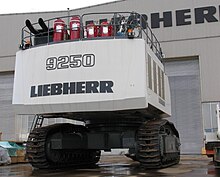

Description
Colmar is a town in the Grand Est region of northeastern France, near the border with Germany. Its old town has cobblestone streets lined with half-timbered medieval and early Renaissance buildings. The Gothic 13th-century, Eglise Saint-Martin church stands on central Place de la Cathédrale. The city is on the Alsace Wine Route, and local vineyards specialize in Riesling and Gewürztraminer wines.




Uma das mais charmosas cidades do mundo: Colmar, na França ?
Colmar
Jump to navigation Jump to search
|
This article needs additional citations for verification. (June 2012) (Learn how and when to remove this template message)
|
|
Colmar
|
|
|---|---|
|
Prefecture and commune
|
|

The little Venice, Colmar
|
|
|
Location of Colmar
|
|
| Coordinates: 48°04′54″N 7°21′20″ECoordinates: 48°04′54″N 7°21′20″E | |
| Country | France |
|---|---|
| Region | Grand Est |
| Department | Haut-Rhin |
| Arrondissement | Colmar-Ribeauvillé |
| Canton | Colmar-1 and 2 |
| Intercommunality | Communauté d’agglomération de Colmar |
| Government | |
| • Mayor (2014–2020) | Gilbert Meyer |
| Area
1
|
66.57 km2 (25.70 sq mi) |
| Population
(2016)2
|
69,899 |
| • Density | 1,100/km2 (2,700/sq mi) |
| Time zone | UTC+01:00 (CET) |
| • Summer (DST) | UTC+02:00 (CEST) |
| INSEE/Postal code |
68066 /68000
|
| Dialling codes | 0389 |
| Elevation | 175–214 m (574–702 ft) (avg. 197 m or 646 ft) |
| 1 French Land Register data, which excludes lakes, ponds, glaciers > 1 km2 (0.386 sq mi or 247 acres) and river estuaries. 2 Population without double counting: residents of multiple communes (e.g., students and military personnel) only counted once. | |
Colmar (French: Colmar, pronounced [kɔlmaʁ]; Alsatian: Colmer [ˈkolməʁ]; German during 1871–1918 and 1940–1945: Kolmar) is the third-largest commune of the Alsace region in north-eastern France. It is the seat of the prefecture of the Haut-Rhin department and the arrondissement of Colmar-Ribeauvillé.
The town is situated on the Alsatian Wine Route and considers itself to be the “capital of Alsatian wine” (capitale des vins d’Alsace). The city is renowned for its well-preserved old town, its numerous architectural landmarks, and its museums, among which is the Unterlinden Museum, with the Isenheim Altarpiece.
History
|
Imperial City of Colmar
|
|||||||
|---|---|---|---|---|---|---|---|
| 1226–1679 | |||||||
| Status | Imperial City | ||||||
| Capital | Colmar | ||||||
| Common languages | Alsatian | ||||||
| Government | City-state | ||||||
| Historical era | Middle Ages | ||||||
|
• Immediacy granted by Frederick II
|
1226 | ||||||
|
• Joined Décapole
|
1354 | ||||||
| 1673 | |||||||
|
• Ceded at Nijmegen
|
1679 | ||||||
|
|||||||
Colmar was founded in the 9th century and is mentioned as Columbarium Fiscum by the monk Notker Balbulus in a text dated 823.[citation needed] This was the location where the Carolingian Emperor Charles the Fat held a diet in 884.[citation needed] Colmar was granted the status of a free imperial city by Emperor Frederick II in 1226.[citation needed] In 1354 it joined the Décapole city league.[citation needed] In 1548 Josel of Rosheim urged the Reichskammergericht court to repeal the Colmar market ban on Jewish merchants.[citation needed] The city adopted the Protestant Reformation in 1575, long after the northern neighbours of Strasbourg and Sélestat.[citation needed] During the Thirty Years’ War, it was taken by the Swedish army in 1632, which held it for two years. In 1634 the Schoeman family arrived and started the first town library. In 1635 the city’s harvest was spoiled by Imperialist forces while the residents shot at them from the walls.[1]
The city was conquered by France under King Louis XIV in 1673 and officially ceded by the 1679 Treaties of Nijmegen.[citation needed] With the rest of Alsace, Colmar was annexed by the newly formed German Empire in 1871 as a result of the Franco-Prussian War and incorporated into the Alsace-Lorraine province.[citation needed] It returned to France after World War I according to the 1919 Treaty of Versailles,[citation needed] was annexed by Nazi Germany in 1940, and then reverted to French control after the battle of the “Colmar Pocket” in 1945.[citation needed] Colmar has been continuously governed by conservative parties since 1947, the Popular Republican Movement (1947–1977), the Union for French Democracy (1977–1995) and the Union for a Popular Movement (since 1995), and has had only three mayors during that time.[citation needed]
The Colmar Treasure, a hoard of precious objects hidden by Jews during the Black Death, was discovered here in 1863.[citation needed]
Geography
Colmar is 64 kilometres (40 mi) south-southwest of Strasbourg, at 48.08°N, 7.36°E, on the Lauch River, a tributary of the Ill. It is located directly to the east of the Vosges and connected to the Rhine in the east by a canal.
In 2013, the city had a population of 67,956,[2] and the metropolitan area of Colmar had a population of 126,957 in 2009.[3] Colmar is the center of the arrondissement of Colmar-Ribeauvillé, which had 199,182 inhabitants in 2013.[4]
Climate
Colmar has a sunny microclimate and is one of the driest cities in France, with an annual precipitation of just 607 mm (23.9 in), making it ideal for Alsace wine. It is considered the capital of the Alsatian wine region.
The dryness results from the town’s location next to mountains, which force clouds arriving from the west to rise, and much of their moisture to condense and fall as precipitation over the higher ground, leaving the air warmed and dried by the time it reaches Colmar.
| Climate data for Colmar | |||||||||||||
|---|---|---|---|---|---|---|---|---|---|---|---|---|---|
| Month | Jan | Feb | Mar | Apr | May | Jun | Jul | Aug | Sep | Oct | Nov | Dec | Year |
| Record high °C (°F) | 18.5 (65.3) |
21.8 (71.2) |
25.5 (77.9) |
29.6 (85.3) |
34.7 (94.5) |
37.5 (99.5) |
38.7 (101.7) |
40.9 (105.6) |
33.6 (92.5) |
30.7 (87.3) |
24.0 (75.2) |
20.3 (68.5) |
40.9 (105.6) |
| Average high °C (°F) | 4.8 (40.6) |
6.8 (44.2) |
11.9 (53.4) |
16.0 (60.8) |
20.4 (68.7) |
23.7 (74.7) |
26.1 (79.0) |
25.8 (78.4) |
21.4 (70.5) |
15.8 (60.4) |
9.2 (48.6) |
5.5 (41.9) |
15.7 (60.3) |
| Average low °C (°F) | −1.4 (29.5) |
−1.2 (29.8) |
2.0 (35.6) |
4.8 (40.6) |
9.3 (48.7) |
12.3 (54.1) |
14.2 (57.6) |
13.7 (56.7) |
10.2 (50.4) |
6.8 (44.2) |
2.2 (36.0) |
−0.2 (31.6) |
6.1 (43.0) |
| Record low °C (°F) | −22.0 (−7.6) |
−21.2 (−6.2) |
−16.0 (3.2) |
−7.3 (18.9) |
−3.1 (26.4) |
2.1 (35.8) |
4.0 (39.2) |
3.2 (37.8) |
−1.0 (30.2) |
−7.6 (18.3) |
−13.1 (8.4) |
−19.0 (−2.2) |
−22.0 (−7.6) |
| Average precipitation mm (inches) | 31.7 (1.25) |
28.8 (1.13) |
37.4 (1.47) |
44.7 (1.76) |
74.2 (2.92) |
64.2 (2.53) |
66.8 (2.63) |
57.0 (2.24) |
57.8 (2.28) |
56.9 (2.24) |
40.1 (1.58) |
47.7 (1.88) |
607.3 (23.91) |
| Average precipitation days (≥ 1 mm) | 7.1 | 7.0 | 8.5 | 8.9 | 11.2 | 9.6 | 9.4 | 9.1 | 7.9 | 9.3 | 7.3 | 8.5 | 103.9 |
| Average snowy days | 7.0 | 6.2 | 3.6 | 1.1 | 0.0 | 0.0 | 0.0 | 0.0 | 0.0 | 0.0 | 2.7 | 5.1 | 25.7 |
| Average relative humidity (%) | 87 | 82 | 76 | 74 | 75 | 72 | 69 | 72 | 76 | 83 | 87 | 88 | 78.4 |
| Mean monthly sunshine hours | 71.8 | 97.0 | 144.7 | 180.2 | 201.5 | 225.5 | 239.2 | 223.6 | 170.7 | 116.9 | 70.5 | 57.5 | 1,799 |
| Source #1: Météo France[5][6] | |||||||||||||
| Source #2: Infoclimat.fr (humidity and snowy days, 1961–1990)[7] | |||||||||||||
Main sights
Mostly spared from the destructions of the French Revolution and the wars of 1870–1871, 1914–1918 and 1939–1945, the cityscape of old-town Colmar is homogenous and renowned among tourists. An area that is crossed by canals of the river Lauch (which formerly served as the butcher’s, tanner’s and fishmonger’s quarter) is now called “little Venice” (la Petite Venise).
Architectural landmarks
Colmar’s secular and religious architectural landmarks reflect eight centuries of Germanic and French architecture and the adaptation of their respective stylistic language to the local customs and building materials (pink and yellow Vosges sandstone, timber framing).
Secular buildings
- Maison Adolph – 14th century (German Gothic)
- Koïfhus, also known as Ancienne Douane – 1480 (German Gothic)
- Maison Pfister – 1537 (German Renaissance).
- Ancien Corps de garde – 1575 (German Renaissance)
- Maison des Chevaliers de Saint-Jean – 1608 (German Renaissance)
- Maison des Têtes – 1609 (German Renaissance)
- Poêle des laboureurs – 1626 (German Baroque)
- Ancien Hôpital – 1736–1744 (French Classicism)
- Tribunal de grande instance – 1771 (French Classicism)
- Hôtel de ville – 1790 (French Classicism)
- Colmar prison –- 1791, formerly a convent built in 1316.
- Cour d’Assises – 1840 (French Neoclassicism)
- Théâtre municipal – 1849 (French Neoclassicism)
- Marché couvert – 1865 (French Neo-Baroque). The city’s covered market, built in stone, bricks and cast iron, still serves today.
- Préfecture – 1866 (French Neo-Baroque)
- Water tower – 1886. Oldest still preserved water tower in Alsace. Out of use since 1984.
- Gare SNCF – 1905 (German Neo-Baroque)
- Cour d’appel – 1906 (German Neo-Baroque)
Religious buildings
- Église Saint-Martin – 1234–1365. The largest church of Colmar and one of the largest in Haut-Rhin. Displays some early stained glass windows, several Gothic and Renaissance sculptures and altars, a grand Baroque organ case. The choir is surrounded by an ambulatory opening on a series of Gothic chapels, a unique feature in Alsatian churches.
- Église des Dominicains – 1289–1364. Now disaffected as a church, displays Martin Schongauer‘s masterwork La Vierge au buisson de roses as well as 14th century stained glass windows and baroque choir stalls. The adjacent convent buildings house a section of the municipal library.
- Église Saint-Matthieu – 13th century. Gothic and Renaissance stained glass windows and mural paintings, as well as a wooden and painted ceiling.
- Couvent des Antonins – 13th century. Disaffected church and convent buildings notable for a richly ornate cloister. Now housing the Unterlinden Museum (see below).
- Église Sainte-Catherine – 1371. Disaffected church and convent buildings now used as an assembly hall and festival venue (Salle des Catherinettes).
- Chapelle Saint-Pierre – 1742–1750. Classicist chapel of a former Jesuit college.
- Synagogue – 1843 (Neoclassicism)
Fountains
- Fontaine de l’Amiral Bruat – 1864 (Statue by Bartholdi)
- Fontaine Roeselmann – 1888 (Statue by Bartholdi)
- Fontaine Schwendi – 1898 (Statue by Bartholdi)
Monuments
- Monument du Général Rapp – 1856 (first shown 1855 in Paris. Statue by Bartholdi, his earliest major work)
- Monument Hirn – 1894 (Statue by Bartholdi)
- Statue Les grands soutiens du monde − 1902 (in the courtyard of the Bartholdi Museum)
- Statue of Liberty replica
Museums
- Unterlinden Museum – one of the main museums in Alsace. Displays the Isenheim Altarpiece, a large collection of medieval, Renaissance and baroque Upper-Rhenish paintings and sculptures, archaeological artefacts, design and international modern art.
- Musée Bartholdi – the birthplace of Frédéric Auguste Bartholdi shows his life and work through paintings, drawings, family objects and furniture as well as numerous plaster, metal and stone sculptures. A section of the museum is further dedicated to the local Jewish community’s heritage.[8]
- Musée d’histoire naturelle et d’ethnographie – the zoological and ethnographic museum of Colmar was founded in 1859. Besides a large collection of stuffed animals and artefacts from former French and German colonies in Africa and Polynesia, it also houses a collection of ancient Egyptian items.
- Musée du jouet – the town’s toy museum, founded 1993
- Musée des usines municipales – industrial and technological museum in a former factory, dedicated to the history of everyday technology.
Library
The Municipal Library of Colmar (Bibliothèque municipale de Colmar) owns one of the richest collections of incunabula in France, with more than 2,300 volumes.[9] This is quite an exceptional number for a city that is neither the main seat of a university, nor of a college, and has its explanation in the dissolution of local monasteries, abbeys and convents during the French Revolution and the subsequent gift of their collections to the town.
Transport
The small regional Colmar Airport serves Colmar.
The railway station Gare de Colmar offers connections to Strasbourg, Mulhouse, Besançon, Zürich and several regional destinations. Colmar was also once linked to Freiburg im Breisgau, in Germany and on the other side of the Rhine, by the Freiburg–Colmar international railway. However the railway bridge over the Rhine between Breisach and Neuf-Brisach was destroyed in 1945 and never replaced.
Education
|
This section needs expansion. You can help by adding to it. (April 2015)
|
Senior high schools in Colmar include:
- Lycée Bartholdi
- Lycée Camille Sée
- Lycée polyvalent Blaise Pascal
- Lycée polyvalent Martin Schongauer
- Lycée privé Saint-André
- Lycée professionnel privé Saint-Jean
- Ecole privée Mathias Grunewald
Colmar shares the Université de Haute-Alsace (Upper Alsace University) with the neighbouring, larger city of Mulhouse. Of the approximately 8,000 students of the UHA, around 1,500 study at the Institut universitaire de technologie (IUT) Colmar, at the Colmar branch of the Faculté des Sciences et Techniques and at the Unité de Formation et de Recherche Pluridisciplinaire d’Enseignement Professionalisé Supérieur (UFR PEPS).
The École Compleméntaire Pour L’Enseignement Japonaise a Colmar (コルマール補習授業校 Korumāru Hoshū Jugyō Kō), a part-time supplementary Japanese school, is held in Colmar.[10] At one time classes were held at the Centre Cultural de Seijo.[11]
Music
Since 1980, Colmar is home to an international summer festival of classical music Festival de Colmar (also known as Festival international de musique classique de Colmar). In its first version (1980 to 1989), it was placed under the artistic direction of the German conductor Karl Münchinger. Since 1989, it is helmed by the Russian violinist and conductor Vladimir Spivakov.
Economy
Colmar is an affluent city whose primary economic strength lies in the flourishing tourist industry. But it is also the seat of several large companies: Timken (European seat), Liebherr (French seat), Leitz (French seat), Capsugel France (A division of Pfizer).
Every year since 1947, Colmar is host to what is now considered as the biggest annual commercial event as well as the largest festival in Alsace,[12] the Foire aux vins d’Alsace (Alsacian wine fair).
When Air Alsace existed, its head office was on the grounds of Colmar Airport.[13]
Parks and recreation
By 1991 Lycée Seijo, a Japanese boarding high school in Kientzheim, had established a Japanese cultural center. It housed books and printed materials in Japan and hosted lectures and film screenings.[14]
















